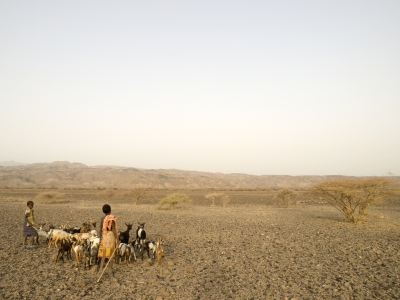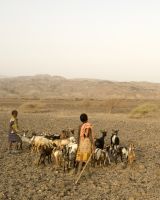 Drought in Ethiopia.The Des Moines Register‘s Philip Brasher is in Africa reporting on the potential for GMO crops to help alleviate hunger in the developing world. The current focus is on drought-tolerant crops for obvious reasons:
Drought in Ethiopia.The Des Moines Register‘s Philip Brasher is in Africa reporting on the potential for GMO crops to help alleviate hunger in the developing world. The current focus is on drought-tolerant crops for obvious reasons:
I grew up in western Texas and covered the Midwest’s devastating drought of 1988. I know what a drought looks like, but I’ve never seen anything like the devastation to a portion of the Rift Valley near the Tanzania border.
The savanna, where locals said the grass should be as much as 2 feet high, is barren except for scattered acacia trees and cattle carcasses baking in the sun. Maasai tribesmen, distinctive for their long poles and colorful wraps, were herding along a road a few emaciated cattle that were barely recognizable as dairy cows. There, the cattle, ribs showing and udders shrunken, could forage in small patches of grass, barely an inch tall, that have grown where what rain that has fallen has pooled. It’s the only green in sight.
… Farmers said they haven’t had a good year of rainfall since 2005.
Now, you could ask yourself why these African farmers continue to plant water-intensive crops like corn. But let’s leave that issue aside for the moment (though Brasher says it’s because “it’s what they want to eat”). The important issue is that the big biotech companies have now targeted Africa:
[S]cientists plan next year to try a plot of corn lines that are being genetically engineered to yield better than conventional hybrids when rainfall is insufficient. That’s a common problem throughout east Africa with corn, a staple food crop that isn’t particularly well suited to the region because of the lack of reliable precipitation. The corn will contain a gene that U.S. biotech giant Monsanto Co. developed and contributed to the project. Monsanto would like to see the African version available to poor farmers when the company rolls out more sophisticated drought-tolerant corn seeds in the United States over the next decade.
That phrasing suggests Monsanto is willing to donate its patent rights for the public relations benefit the good of humanity, which is nice.
But in a definite bit of lead-burying, Brasher observes towards the end of his article that:
How valuable this biotech crop turns out to be remains to be seen, of course. That depends on how effective this gene is in the African cultivars it will be tested in, and then there’s the small problem of getting into the hands of farmers without a well-developed system to distribute seeds to poor farmers for whom they are intended.
That “small problem” is THE problem. Biotech boosters from USDA Chief Tom Vilsack to the Earth Institute’s Jeffrey Sachs love to tout the (so far untapped) potential for GMOs to “feed the world.” Yet even if a magic seed is finally invented, they’ll need to invent a magic carpet to go along with it — how else will they distribute it in countries that lack sophisticated road and rail infrastructure or fleets of diesel trucks and rolling stock or vast fuel stockpiles?
It’s as much for this reason as any other that the World Bank’s recent landmark agriculture report downplayed the potential for GMOs to address hunger and focused instead on agro-ecological techniques that don’t come with a big price tag or a need for an extensive transportation system. But try telling that to the Obama administration, which has yoked its development aid reforms to massive increases in funding for research into biotech crops. We’re so blinded by the glare of shiny, new toys that we’ve forgotten that “technology” and “innovation” are not always the same thing. Reading articles like Brasher’s simply confirm that the biggest “problem” with improving agriculture worldwide and addressing global hunger is that the fixes are all maddeningly low-tech.



